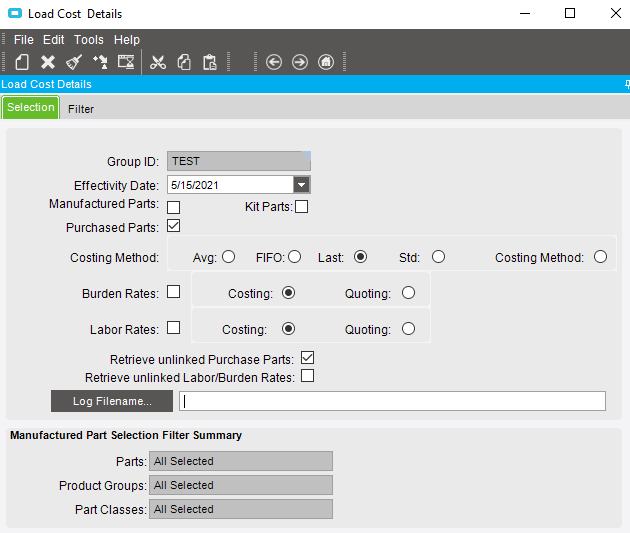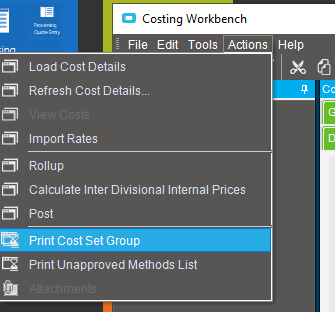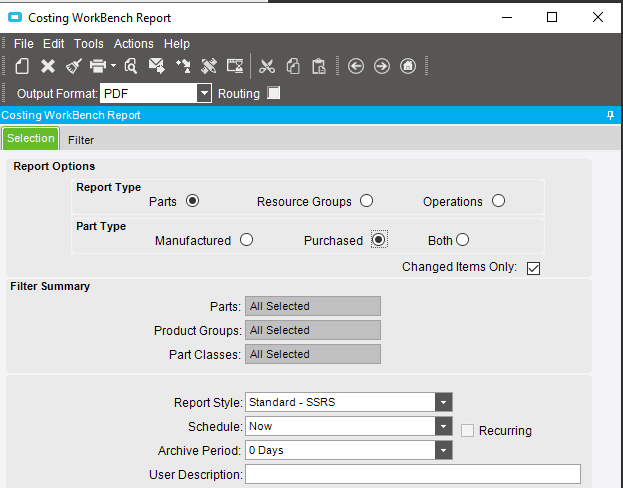I need to understand our standard cost. We are going to be updating the standard for parts in inventory. How do we update standards? do we need to do a cost adjustment as well? new to standard cost I understand the theory but need to know what we need to do in Epicor.
I might start with the Job Cost Tech Ref Guide.
There should be a link to download a PDF from your embedded help in E10 via the F1 key.
Ref screen shot…

Manufactured parts can be done ith the Cost Roll-up Workbench (be warned, it’s not very straightforward).
Purchased parts can be done with cost adjustment. I think there is a way to do it in Cost Rollup as well.
If you have DMT, the cost adjustments can be done in mass.
We overwrite our Standard costs with Last Cost Paid (Where higher) once a year. We use the DMT tool. Very quick and painless.
 IF you’re actually a standard cost user, you’ll want to do the Cost Roll up in your BOMs or you’re going to throw a lot of variances when the sum of your costs don’t equal the assembly costs.
IF you’re actually a standard cost user, you’ll want to do the Cost Roll up in your BOMs or you’re going to throw a lot of variances when the sum of your costs don’t equal the assembly costs.
We did our Standards roll in two steps:
First we did only the purchase parts. Loaded them into the CostingWB and loaded the LastPaid field as a starter. We exported the list to Excel. We also exported a BAQ with all Cost fields. I had plans to add the last year of receipts with PO information and quantities to spot more expensive Engineering buys.
We then posted the purchase part updates.
Second, we did Manufacturing and Kits. Finance would do a burden study once a year and update the Resource Group labor and burden rates. We rolled manufacturing costs and then posted them.
Quick question for Std Costing of make to order parts.
If I have a Part On The Fly (POTF - no part entry, and hence no BOM), is the StdCost for a job to make that from the estimated material costs of the job’s MOM?
Say it uses 5 stocked parts (which use StdCost themselves), and one Buy To Job (BTJ) part. The BTJ part is entered with an estimated cost of $5, but actually comes in at $6.
When the job is completed, shipped and billed, is the COS $1 higher than what the MOM calculates, or is the COS spot on, and a $1 Variance is created?
Ok that was my thought but I wasn’t sure.
- update purchased parts
- update manufactured parts with roll up.
I am not sure the consequences will be what we want. We have a tendency to not use BOM or keep them up to date. What would happen in the event of an empty BOM?
My guess would be that it would calculate to zero, and not throuw a warning or error. FWIW - You can run cost roll-up on select parts. So you can check the outcomes as you’re going.
Are you using Parts on the Fly a lot or inventory parts without MOMs? You really want to have good MOMs for Standard Costing.
I believe there’s an option to skip parts without MOMs or Unapproved Revs. Otherwise, I’m pretty sure you will get a zero.
Practice in your TEST/PILOT system!!! ![]()
I am new to Epicor and DMT. I have created the file to update the purchased parts for IT to upload. Once uploaded how do I roll the costs?
We need to update labor and overhead rates as well. That goes through the costing workbench, I believe. I have created a DMR file to update Labor and Overhead. When I tried to test it, it zeroed out the labor and overhead.
Any assistance would be appreciated.
Hi Marcia,
I updated the ProdLabRate by using the DMT with the ResourceGroup table. There are a few other rates you can modify there as well, such as QProdLabRate, ProdBurRate, SetupBurRate etc etc
Best regards
Adrian.
@Mark_Wonsil what do you mean “and loaded the LastPaid field as a starter”?
Right now I am being told that when we do a cost roll on purchased parts it will roll the last cost into the standard costs… I don’t see that happening… Does it really do that or do we have to do a query to get last cost for all the purchased parts and use quantity adjustment dmt to set the purchased part standard cost to the last cost?
What happens if you load with these options?

I see Mark.
So if I choose Last here, it will load the parts with their last cost.
So if I am understanding it correctly, I should load the last cost like you have shown. And then when I post, it will post that to the standard cost as this is their site /part set costing method, is that correct?
Not saying this is what you should do. Some people load the previous standard and then mark it up. It’s just what we did. Prove it out in your Test/Pilot to make sure that it’s bringing in the Last price.
We would then run the Cost Difference report to see which have changed and by how much. Then accounting and purchasing would review the big movers. Sometimes a spot buy for Engineering would be last and more expensive than a thoughtful standard based on some predicted usage. Here’s your chance to get rid of zeros as well. Watch out for obsolete parts too. Obsolete parts should be disposed without costs but sometimes…
Makes sense, but where do I find the cost difference report? Are you talking about the print cost group set report?


Okay thank you, I JUST ran this as you posted and edited my question above 
Sorry about that! I forgot what it was called…